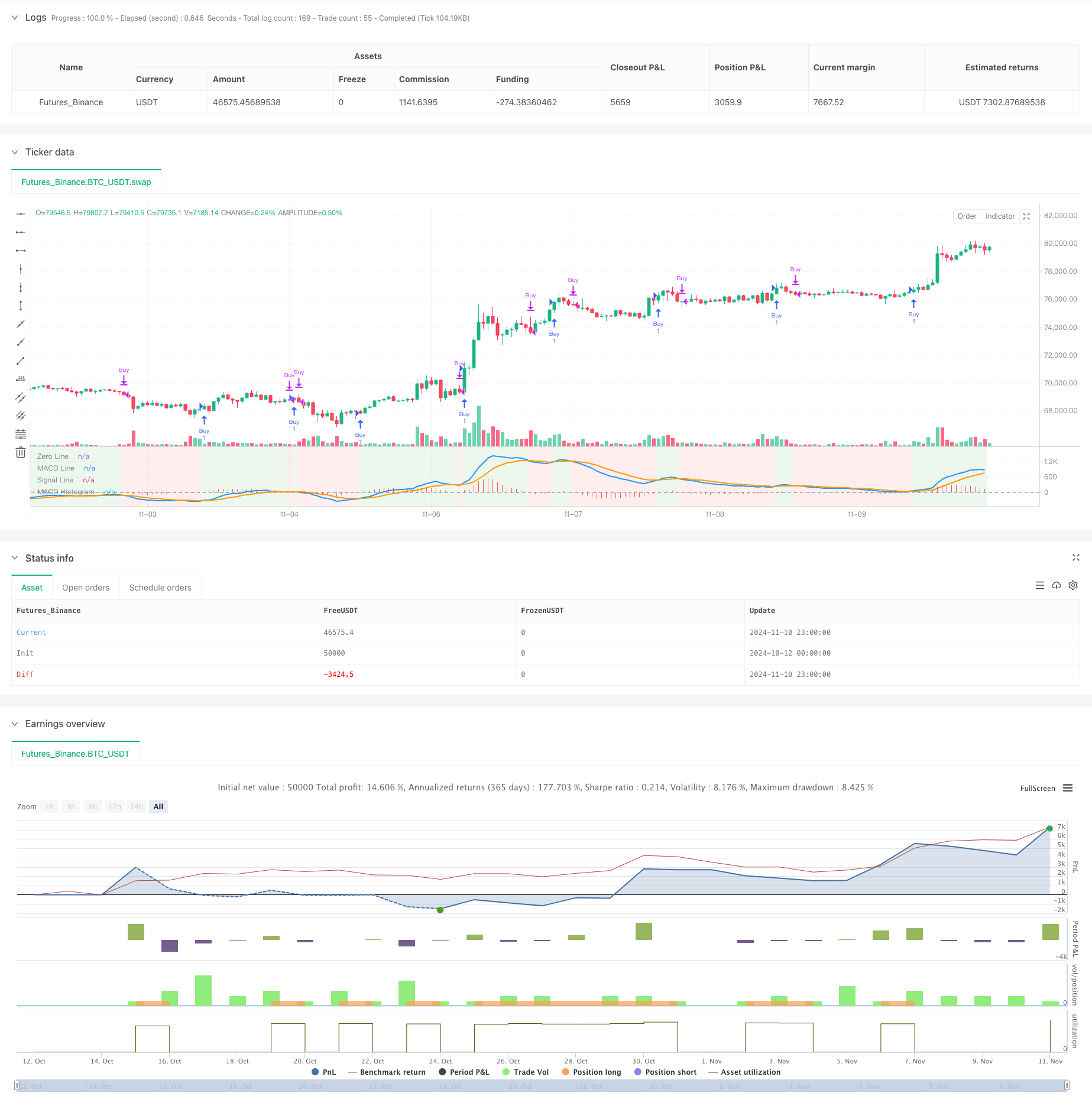
概述
这个策略是一个基于MACD(移动平均线收敛发散指标)的高级量化交易系统,通过动态背景显示和多种预设参数组合来增强交易决策的准确性。该策略的核心在于通过MACD指标的交叉信号来捕捉市场趋势的转换点,并通过可视化的方式直观地展示市场的多空状态。
策略原理
策略采用了十种不同的MACD参数预设,包括标准设置(12,26,9)、短期(5,35,5)、长期(19,39,9)等,以适应不同的市场环境和交易风格。当MACD线与信号线发生黄金交叉时,系统生成买入信号;当发生死亡交叉时,系统生成卖出信号。策略通过动态背景颜色变化(绿色表示多头,红色表示空头)来增强视觉辨识度,帮助交易者更好地把握市场走势。
策略优势
- 参数灵活性强:提供十种预设参数组合,适应不同市场环境
- 视觉反馈清晰:通过背景颜色动态变化直观显示市场趋势
- 信号明确:基于MACD交叉产生明确的买卖信号
- 适应性强:可用于不同时间周期的交易
- 代码结构清晰:使用switch结构实现参数切换,便于维护和扩展
策略风险
- 滞后性风险:MACD作为滞后指标可能在剧烈波动市场中产生延迟信号
- 假突破风险:在横盘市场中可能产生虚假交叉信号
- 参数依赖性:不同参数组合在不同市场环境下表现差异较大
- 市场条件限制:在剧烈波动或流动性不足的市场环境下可能表现不佳
策略优化方向
- 引入波动率过滤器,过滤掉市场波动过大时期的交易信号
- 添加趋势确认指标,如RSI或ATR,提高信号可靠性
- 实现自适应参数优化,根据市场状况动态调整MACD参数
- 增加止损止盈功能,提高风险管理能力
- 添加交易量分析,提高信号的可靠性
总结
这是一个结构完善、逻辑清晰的MACD策略进阶版本。通过多参数预设和动态视觉反馈,大大提升了策略的实用性和可操作性。虽然存在一些固有的风险,但通过提供的优化方向进行改进后,该策略有望成为一个稳健的交易系统。建议交易者在实盘使用前进行充分的回测,并根据具体市场环境选择合适的参数设置。
策略源码
/*backtest
start: 2024-10-12 00:00:00
end: 2024-11-11 00:00:00
period: 1h
basePeriod: 1h
exchanges: [{"eid":"Futures_Binance","currency":"BTC_USDT"}]
*/
//@version=5
strategy("Hanzo - Top 10 MACD Strategy", overlay=false) // MACD in a separate pane
// Define dropdown options for MACD settings
macdOption = input.string(title="Select MACD Setting",
defval="Standard (12, 26, 9)",
options=["Standard (12, 26, 9)",
"Short-Term (5, 35, 5)",
"Long-Term (19, 39, 9)",
"Scalping (3, 10, 16)",
"Cryptocurrency (20, 50, 9)",
"Forex (8, 17, 9)",
"Conservative (24, 52, 18)",
"Trend-Following (7, 28, 7)",
"Swing Trading (5, 15, 5)",
"Contrarian (15, 35, 5)"])
// MACD setting based on user selection
var int fastLength = 12
var int slowLength = 26
var int signalLength = 9
switch macdOption
"Standard (12, 26, 9)" =>
fastLength := 12
slowLength := 26
signalLength := 9
"Short-Term (5, 35, 5)" =>
fastLength := 5
slowLength := 35
signalLength := 5
"Long-Term (19, 39, 9)" =>
fastLength := 19
slowLength := 39
signalLength := 9
"Scalping (3, 10, 16)" =>
fastLength := 3
slowLength := 10
signalLength := 16
"Cryptocurrency (20, 50, 9)" =>
fastLength := 20
slowLength := 50
signalLength := 9
"Forex (8, 17, 9)" =>
fastLength := 8
slowLength := 17
signalLength := 9
"Conservative (24, 52, 18)" =>
fastLength := 24
slowLength := 52
signalLength := 18
"Trend-Following (7, 28, 7)" =>
fastLength := 7
slowLength := 28
signalLength := 7
"Swing Trading (5, 15, 5)" =>
fastLength := 5
slowLength := 15
signalLength := 5
"Contrarian (15, 35, 5)" =>
fastLength := 15
slowLength := 35
signalLength := 5
// MACD Calculation
[macdLine, signalLine, _] = ta.macd(close, fastLength, slowLength, signalLength)
macdHist = macdLine - signalLine
// Buy and Sell conditions based on MACD crossovers
enterLong = ta.crossover(macdLine, signalLine)
exitLong = ta.crossunder(macdLine, signalLine)
// Execute buy and sell orders with price labels in the comments
if (enterLong)
strategy.entry("Buy", strategy.long, comment="Buy at " + str.tostring(close, "#.##"))
if (exitLong)
strategy.close("Buy", comment="Sell at " + str.tostring(close, "#.##"))
// Plot the signal price using plotchar for buy/sell prices
//plotchar(enterLong ? close : na, location=location.belowbar, color=color.green, size=size.small, title="Buy Price", offset=0)
//plotchar(exitLong ? close : na, location=location.abovebar, color=color.red, size=size.small, title="Sell Price", offset=0)
// Background highlighting based on bullish or bearish MACD
isBullish = macdLine > signalLine
isBearish = macdLine < signalLine
// Change background to green for bullish periods and red for bearish periods
bgcolor(isBullish ? color.new(color.green, 90) : na, title="Bullish Background")
bgcolor(isBearish ? color.new(color.red, 90) : na, title="Bearish Background")
// Plot the MACD and Signal line in a separate pane
plot(macdLine, title="MACD Line", color=color.blue, linewidth=2)
plot(signalLine, title="Signal Line", color=color.orange, linewidth=2)
hline(0, "Zero Line", color=color.gray)
plot(macdHist, title="MACD Histogram", style=plot.style_histogram, color=color.red)
相关推荐